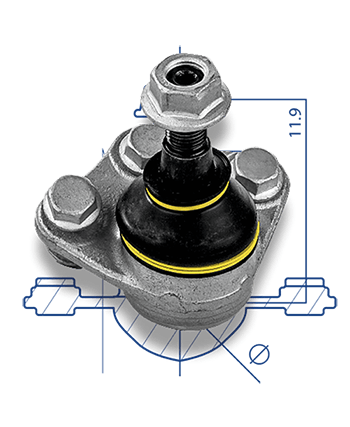How can you check for worn ball joints?It’s possible that the symptoms of worn ball joints develop slowly, so you don’t notice for a while. But, if you have noticed any of the symptoms above, or would just like to double-check your ball joints, it’s best to first check your ball joints when driving before doing a visual inspection. How to check your ball joints when drivingChecking your ball joints when driving is straightforward, simply: 1. Take your car out for a drive
Drive the vehicle on a public road at the speed limit and pay close attention to the engine, steering and overall performance of the car. What to look out for
Vibrations – when a ball joint wears out, it becomes loose which can create a vibration that you can feel through the floor or the steering wheel while you drive. Steering wheel wandering to the left or the right – worn ball joints cause the steering to pull from left to right on its own. This can also cause uneven wear on your tyres. 2. Drive over speed bumps
After driving at the speed limit, take it somewhere with speed bumps and drive it at a low speed. Stop and go a few times, and turn a few times. What to look out for
Noise – this can be a clunking or squeaking noise. Clunking noises are caused by the worn ball joints rattling as the suspension travels up and down over the road. The squeaking noise is caused by the rubber boot that protects the grease inside the ball joint is damaged, the ball joint will start to squeak. These noises will get louder the more worn the ball joints become. 3. Turn the steering wheel
The last step is to park the car and turn the wheels back and forth a few times while listening for noise from the ball joints. How to check ball joints visuallyAfter checking your ball joints while driving, it’s time for a visual and physical inspection. Before you start, make sure you have the following tools ready: - Jack
- Jack stands
- Flashlight
- Pry bar
- Lug nut wrench
- Wooden blocks or wheel chocks
A visual and physical inspection has the following steps: 1. Check your tyre wear Loose ball joints can’t keep your suspension aligned while you drive. This accelerates tyre wear by causing the rubber tread to touch the ground in an inconsistent way. If you notice feathering (i.e. uneven spots of wear on a tyre) or that the front of the wheels points out (i.e. toe-out), there’s a good chance that your ball joints will need further investigation. However, if the tyre wear is equal on both sides, then the issue is probably not your ball joints, but due to under-inflation of the tyres. 2. Loosen the lug nuts Loosen the lug nuts so they are hand-tight. This will allow you to move the wheel around on its axis, without removing it completely. 3. Jack up the car and place wheel chocks behind the wheels Jack the front of the car up and secure it on jack stands. Put wheel chocks or wooden blocks behind the back wheels to prevent the car from rolling. This will make it easier to test the ball joints. 4. Rock the tyre on its axis Grasp the top and bottom of the tyre and rock it in and out along the wheel’s vehicle axis. If the ball joints are working well, there should be little to no play in this movement. What to look out for Noise and play from the top – this indicates a problem with the upper ball joint. Noise and play from the bottom – this suggests a problem with the lower ball joint. 5. Remove the wheel Remove the wheel and use a flashlight to visually check the upper and lower ball joints. What to look out for Can you see any signs of rust, damage to the dust boot, grease leakage or any other potential problem? If so, it’s probably time to replace your ball joint. 6. Pry the ball joint apart Use the pry bar and attempt to pry the lower control arm and the steering knuckle (the two components connected by the ball joint). What to look out for Excessive amounts of play and movement or clicking sounds are a sign that your ball joints are too loose. 7. Put the wheel back on After you have finished visually inspecting and testing the ball joint, replace the wheel, lower the car and torque the lug nuts. 8. Repeat with the other wheels After you have finished the first wheel, you need to check the other three, by following steps 2-7. Quality ball jointsWhen replacing your ball joints, it’s important to go for quality – after all, your ball joints have to support the weight of your entire car. Polish Venture has a range of quality, premium ball joints for all makes and models. Contact us to find the right ball joints for your car. Source: MOOG | 
